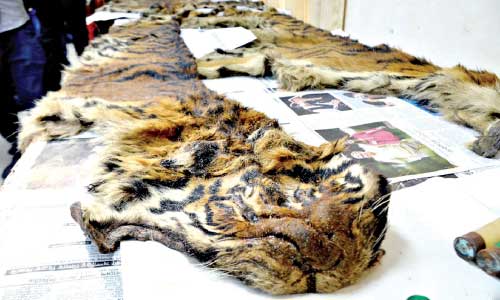The three tigers were poisoned: forest dept
Three adult Royal Bengal Tigers were poisoned to death by poachers at the Sundarbans in last three months, claimed an investigation report of the forest department in the wake of the recovery of three tiger hides on Sunday.
The incidents further cast a blow to the recently held census in which the number of tigers living in Sundarbans was counted at 106 – a sharp decline from previous counts.
The police seized the three tiger pelts during a raid in which six suspected tiger poachers were shot dead in a gunfight at a hideout in the world’s largest mangrove forest.
Divisional Forest Officer of Sundarban West Forest Division Zahir Uddin Ahmed told New Age the probe body submitted its investigation report Tuesday afternoon hinting the poachers killed the tigers under a deal worth at least Tk 30 lakh.
The investigation committee, however, could not ascertain the final destination of skins and the masterminds of the racket.
The four-member probe body headed by the assistant conservator of forests, in charge of Satkhira range, Md Shoaib Khan suspected the poachers killed the tigers in the Khulna range of Sundarbans.
One of the members of the probe body said they could not found any mark of injury caused by bullets or sharp weapons on the hide.
‘We suspect the tiger was killed by poisoning,’ the member said.
Divisional Forest Officer of Sundarban West Forest Division Zahir Uddin said this was the latest incident of tiger killing after the recovery of the bones of a tiger on Friday. ‘After examining the bones we suspect the tiger was either killed or died about six month ago,’ he said.
Police arrested two suspected poachers with 69 pieces of bones from Natun Bazar launch terminal in the district town on Friday.
The survey report and conservationists said poaching, the under construction coal-fired Rampal power plant, other development activities and river vessel traffic were threats to the unique biodiversity of the Sunderbans.
Experts and the last tiger census report found poaching to be one of the main reasons for the decline in the number of Royal Bengal tigers.
According to the survey findings tiger density was adversely affected by human disturbance which was high in the Bangladesh side of the Sunderbans compared to the Indian part.
It blamed increasing commercial boat traffic, development activities around the Sundarbans and poaching of tigers and their prey for the low density of the big cats in the Bangladesh part of the mangrove forest.
The Deputy Commissioner of Khulna district Md Mostafa Kamal at a press conference on Tuesday suggested the forest department stop giving permission from now on to honey collectors and woodcutters.
‘Because, it is not possible for forest department to identify who is a genuine honey collector or poacher. Poachers are entering the forest in the guise of honey collectors or wood cutters and doing damage to Bengal tigers,’ he said.
He stressed need for taking preventive measures to save tigers from being killed, which needs to be monitored by the forest department officials.
- See more at: http://newagebd.net/146679/the-three-tigers-were-poisoned-forest-dept/#sthash.efpPkj4y.dpuf











